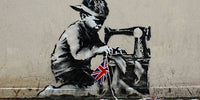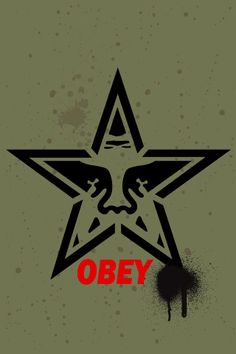
About the stencil in the street art
, 4 min reading time

, 4 min reading time
When talking about street art, it is unavoidable to think about stencil. Many artists use this technique to depict their works due to its advantages compared to other forms of expression, also very common in urban art. The stencil is a fast and efficient way of transmitting a message and thus, it has always been linked to an image of revelry and authenticity. Artists such as Banksy or his predecessor, Blek Le Rat, have helped to expand and internationalize this technique that has a past considerably more distant.
But, what does the stencil consist of? This media is simple and basically entitles creating a negative image or form by cutting a flat surface (a cardboard, for example), creating the stencil itself. Following, it is placed on the medium and spray paint is applied over it, so the positive left is depicted on that surface.
Without turning back to its most ancestral origins, the clearest reference of graffiti stencil as we know it today, has its roots in the World War II. The American army used stencils to place them on the equipment of their different units and tagging them this way so everyone knew to which division the soldier belonged to. But not only during war times the "stencil tagging" was born. Soldiers on both sides also used stencils to identify paths with symbolic images, painting them on the floor or over the building's walls, or to fill the enemy with fear, by decorating their heavy weapons with skulls or wild animals.
 |
 |
 |
In the meantime, the first stencils on walls were firstly seen in Europe, in this occasion with a more political claim sense. These were used to show messages against the government. As mentioned before, the stencil is fast, a pretty good advantage when committing an illegal activity. On the other side, these messages on walls were also very useful as political propaganda. For example, the Italian dictator Mussolini used this stencil messages to influence the citizens.
 |
 |
This same philosophy of spreading political messages was appropriated decades later by the punk movement, very attached to a DIY (do it yourself) style. Bands like the British Crass, left a statement of their political views during the 70s across many cities in the United Kingdom.
This trend of attaching political messages with band names rooted so much into the punk scene that even the great Shepard Fairey recognises that his beginnings in urban art didn't come from the graffiti but from the punk propaganda of bands like Black Flag, Sex Pistols or The Clash.

 |
 |
Nowadays, the most popular urban artist at a global level is Banksy but, as we said long before on our post "Urban art, from the streets to the art galleries", the father of graffiti stencil as we know it today, is Blek Le Rat.
This French artist began creating his first works with spray paint in Paris by the early 80s. Through the stencil, Blek Le Rat managed to step aside from the New York graffiti style, which by those years was at its best thanks to artists such as Keith Haring or Jean-Michel Basquiat. Bleck Le Rat was the first one to provide the stencil technique with the fame that has today, thanks to his rats and real size human figures.
Blek Le Rat began his invasion of the French capital in 1981 drawing little rats in many different corners of the city. This rats (RAT is the acronym for ART) turned then into the artists unique stamp and a symbol of creativity and freedom. A bit later, in 1983, and inspired by Richard Hambleton and Pigneon-Ernest's works, Blek Le Rat created a series of human figures that depicted the image of an old man. The artist borrowed it from a picture illustrating an article on a newspaper which related the current situation in Northern Ireland. That man appeared in the picture yelling at soldiers that were intimidating the civils with their weapons. This man's attitude was taken by Blek Le Rat as a symbol of riot, freedom and, most of all, bravery.